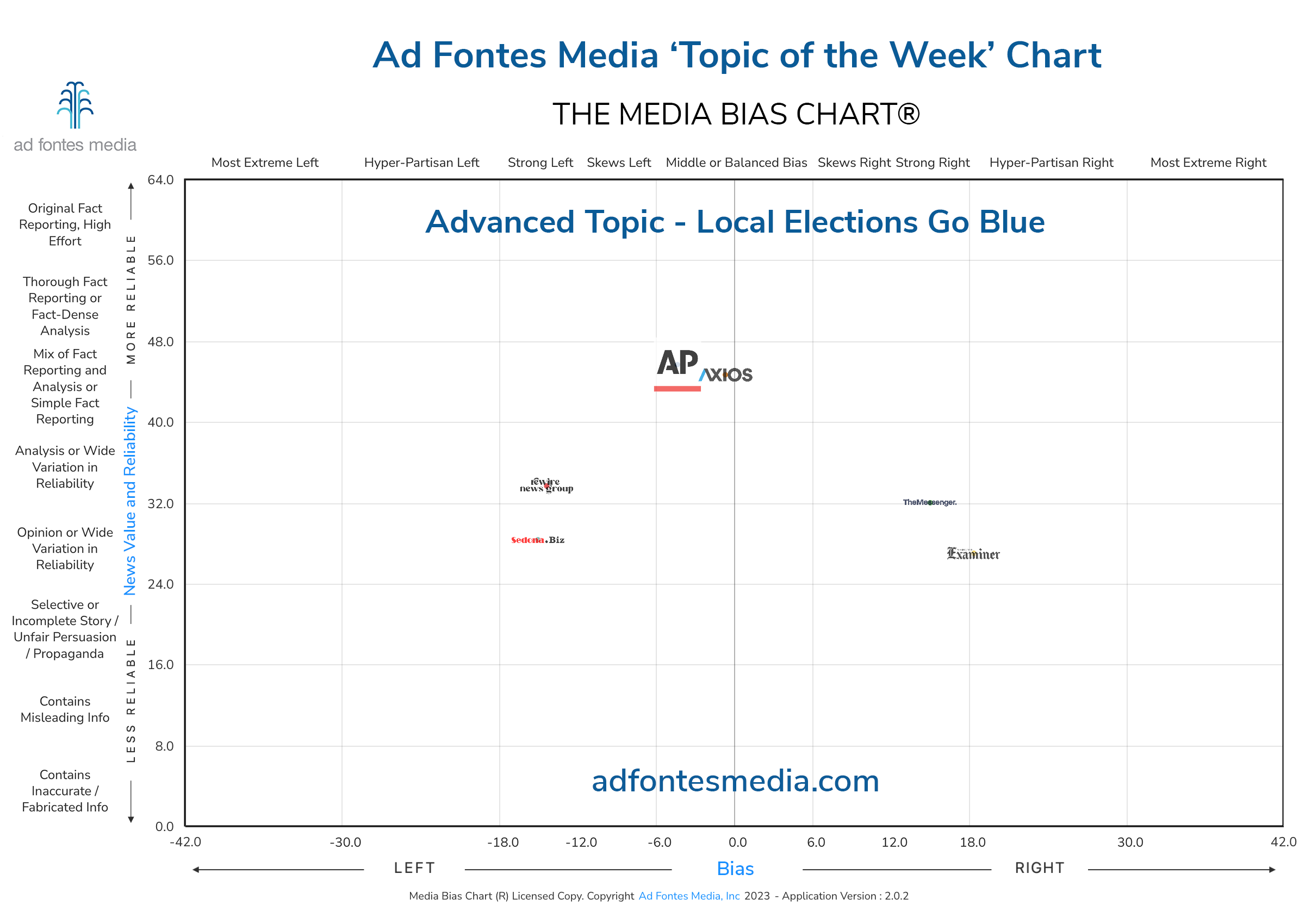Menu

Media Bias Chart Explores News Coverage of Local Elections Going Blue
Ad Fontes Media explains bias, reliability, and polarized reactions in this week’s Topic of the Week
Author:
Sara Webb
Date:
11/17/2023
November 7 was Election Day in the U.S., and there was much media coverage about the results, which were described as a blue wave. Our analysts took a closer look at some of these articles in our Topic of the Week.
Each week, Ad Fontes Media chooses a widely covered trending news topic to share insight into how our analysts rank news coverage for the Media Bias Chart®. To do this, we select six articles reporting on the same story from different outlets to show how each treated the subject.
Once we choose a set of articles, pods of analysts with diverse political perspectives (one right leaning, one center, and one left leaning) read each article and use Ad Fontes Media’s content analysis methodology to determine its bias and reliability. These ratings inform the articles’ placement on that week’s special Media Bias Chart.
This week the article set focused on the national reactions to the results of the local elections. It seems that many of those victories were fueled by the Supreme Court overturning the 1973 Roe v. Wade decision that protected the right to abortion in the United States in January 2022.
The articles rated by our analysts were “GOP’s anti-abortion crisis” from Axios, “Marjorie Taylor Greene Fires Back at Hillary Clinton on Abortion: ‘Reproductive Freedom is Baby Murder’” from The Messenger, “Abortion Rights — Republican Waterloo” from Sedona.Biz, “Huge night for the party of abortion, marijuana, and pornography” from The Washington Examiner, “Hey Justice Alito, How’s Overturning Abortion Rights Working Out for You?” from Rewire News, and “Misinformation is flowing ahead of Ohio abortion vote. Some is coming from a legislative website” from the Associated Press. The bias and reliability scores for each of these articles can be found on our Topic of the Week page.
In this week’s blog, we’re going to examine the most polarized reactions from each side in this article set: Sedona.Biz from the left and Washington Examiner from the right. Both of these are labeled as opinion pieces, and each is rather spicy.
Sedona.Biz is primarily a business news website focusing on local news in Sedona, Arizona. We have not rated enough articles to give an overall view of the bias and reliability of this media outlet, so we will just look at the results from this week’s opinion article.
“Abortion Rights — Republican Waterloo” starts off with, “No matter how you cut the cake, toss the dice, deal the cards or slice that pizza, yesterday’s trouncing of Republicans in the elections, proves once again that men have no right telling women what they may or not do with their bodies.” Our analysts identified that the author tends to frame the abortion debate as Republican men vs. Democratic women, which is only partially accurate, and spends a lot of time pontificating on whether voters will continue to support candidates whose stance on abortion changes based on the sentiments of their constituents.
While the article is very critical of the right and in support of left-leaning abortion views, it ends with, “A lot could happen in one year on the political front and world events. But one thing is for sure. The abortion rights fight will be center stage.” If these elections and the responses were any indication, this is an accurate sentiment.
The Washington Examiner is a conservative news website and weekly magazine based in Washington, D.C., that was founded in 2015. It has an aggregate bias rating of 12.55, or strong right, and reliability rating of 34.58, placing it in the analysis or wide variation in reliability section of the chart. The article this week, “Huge night for the party of abortion, marijuana, and pornography,” was rated by our analysts to have a bias rating of 18.33, inching out of strong right into the hyper-partisan right category, and a reliability score of 27, into the opinion and wide variation in reliability category.
Our analysts had no trouble identifying the bias in this article, starting with the title itself, which they said is “hyper-polarizing and very overgeneralizing.” There is a focus on the questionable internet fame of one particular candidate in the Virginia House race, Susanna Gibson, and using that as a lens to seemingly discredit the Democratic party as a whole. The article ends with, “…until abortion fades as a concern, it looks like Democrats are going to win a lot of elections on just that one issue.” This is a different take than the first article, which predicted that this debate will be on stage until a national conclusion is reached.
If you want a look at the larger media landscape or are curious to see how our analysts have rated your favorite sources, head on over to our website and check out the resources we have available. And don’t forget to come back in two weeks (happy Thanksgiving to those who celebrate!) for another examination of the Topic of the Week.
And if you want to stay informed on all of our amazing work, join our free mailing list!


